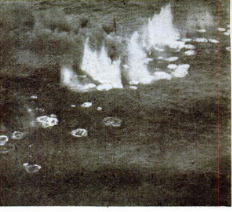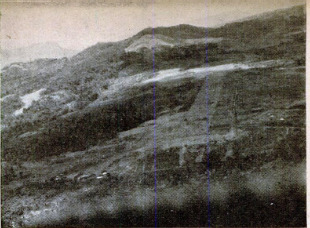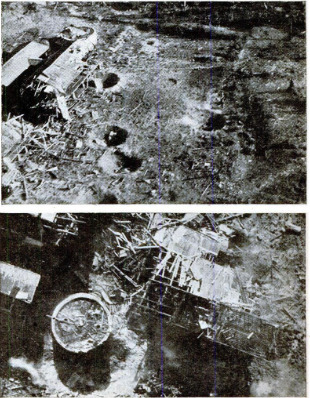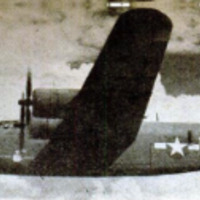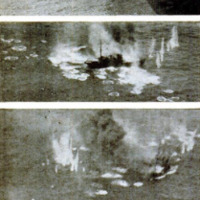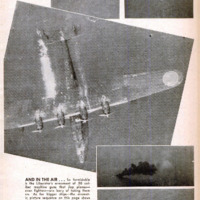-
Title (Dublin Core)
-
Death for tops filies at fifty feet
-
Article Title and/or Image Caption (Dublin Core)
-
Death for tops filies at fifty feet
-
extracted text (Extract Text)
-
AT THE end of its sector, a lone Navy
search plane turned away from home.
For six hours the pilot had flown his Lib-
erator over a huge, empty, and beautifully
‘monotonous pie-slice of ocean trying to find
any Japanese movement by submarine, sur-
face craft, or plane. With Eniwetok, then
the most forward American base in the cen-
tral Pacific, as the apex, the pilot was near
Truk at the end of the pie slice. Instead of
searching the short leg and returning to
base, he flew on toward the great Japanese
bastion.
A hundred miles out, the pilot shoved the
big Liberator down to 50 feet altitude. At
50 miles out, he took it on down to 20 feet.
(The tail gunner said flying fish were going
over his head.). Ini the moonlit darkness the
reef surrounding Truk's lagoon flashed
briefly and the plane was inside the lagoon.
Bow gunner, top-turret gunner, belly gun-
ner, tail gunner, and
the two waist gun-
ners were at battle
stations. The radio-
man on the catwalk
in the bomb bay was
ready to hold the
bomb-bay doors open
in case anything failed
to function. Ahead
and to the south the
hump of Moen, the
largest of Truk's
islands, loomed up,
while directly ahead
little Fanuela Island
rushed at them, swept
below. A mile past
Fanuela, a Japanese
destroyer lay at an-
chor.
‘There were no signs
of the Japs having
been alerted. The
pilot, Comdr. Norman
M. Miller, USN, came
up to 200 feet altitude
and increased his
manifold pressure un-
til he was making
200 miles per hour,
indicated. But the
Japs began to wake.
Searchlights probed
the sky, and the Lib-
erator's crew could
see the yellow-and-
white flashes of the
AA on the shores of
the islands.
Commander Miller
settled into a bomb-
ing run as the de-
stroyer blazed with
antiaircraft fire. The
glare of the guns and
the glare of the bursts
blinded him a little,
ruining his night vi-
sion, and he lowered
his head, watching
his altimeter (200
feet) and his air-
speed meter (200
miles per hour). At
the last second he
looked out again at
the destroyer, now
clearly silhouetted by
its own gunfire, Hold-
ing the bomb-release
button—the “pickle”
—in his right hand,
he waited to squeeze
it until his improvised bombsight told him
he couldn't miss.
The radioman in the bomb bay saw two
1,000-pounders go down, a fraction of a
second apart. The port quarter of the de-
stroyer flashed under, then the long stretch
of the deck, then the starboard bow. The
first bomb hit with a mushroom on the
quarter, the next close on the bow. The
tail gunner watched the mushrooms blos-
som, watched the destroyer lift itself from
the water and fall back. That was all he
saw, for the night suddenly turned to a
hard glare as two searchlights caught full
on the Plexiglas dome in which he sat.
Commander Miller was fighting the jolt-
ing blows of the flak explosions. Two
searchlights on Moen Island held his plane
like a fly impaled on a pin. The altitude
was still 200 feet, for the pilot could not
make any radical maneuvers without fly-
ing the plane into the water. To pull her
up would kill his speed and throw the whole
belly of the plane into the lights for the
guns which were hammering away from
all the positions in range. He eased the big
plane in a gentle turn to the left, away
from the guns. The lights followed him
and the yellow flashes crept to the left.
‘Then he jammed it hard around to the right,
the long wing tipping steeply toward the
water. The Liberator broke out of the grip
of the searchlights and into the welcome
security of darkness.
The searchlights seemed confused and
circled far to the right of the plane. In-
stead of streaking for home, Commander
Miller turned and headed back toward the
airfield on Eten Island. “I'm going down
the runway,” he said to his crew. “Let ‘em
have it!” They went down the runway at
50 feet. Everything that could shoot in his
plane was going full blast and the plane
felt like the inside of a riveting gun. From
the end of the runway they turned again
and flew over the seaplane base, listening
to the tail gunner tallying the damage to
small ships and tenders going up in flames
as the .50 calibers chewed into them. Com-
mander Miller turned again and crossed the
narrow water to Moen Island, racing down
is airstrip with all his guns spraying
everything in sight.
The bombs were all gone and the gun
barrels burned out. The navigator told him
he had been inside Truk’s lagoon for 18
minutes. Commander Miller had one depth
charge left for use against anything he
might find on the way home, and, down at
20 feet again, he gunned the plane over the
white line of the barrier reef and headed
back to complete the outer leg of his search
sector. The Japanese Navy was minus one
destroyer —and that at the very time
when it couldn't afford to lose a rowboat.
Comdr. Norman M. (Bus) Miller, USN,
was commanding officer and pacesetter of
Bombing Squadron 109—a squadron famous
throughout the Pacific for its succession of
daring low-level attacks and its unheard-of
- record of destruction of enemy shipping and
shore installations. This attack could have
been made by any one of his 20 patrol-
plane commanders at any Japanese base in
the central Pacific, for, in 7% months, the
great planes of VB-100, flying singly and
alone, cut a path ahead of our forces
through the Gilberts and Marshalls, the
Carolines, the Marianas, to -the Bonins,
Kazans, and Volcanos within 500 miles of
Japan itself. .
VB-109 was a Liberator squadron. The
Liberator, of course, was designed as a
high-altitude bomber for the Army, and for
best operation at altitudes above 20,000 feet.
At 200 feet it is clumsy, slow, and fairly
unmaneuverable, well meriting its half-de-
risive nickname “boxcar,” but the Navy
needed its range. Known as the PB4Y to
the Navy, the Liberator may carry up to
three-ton bomb loads, and it is armed with
enough .50 caliber machine guns to make
‘Jap fighters very cautious about coming
in. At low altitudes the PB4Y's have no
blind spots, and VB-109 never flew them
high.
With the Mariners and Coronados and
Catalinas, the Navy Liberators are the
Navy's “1,000-mile eyes” and their jéb is
search, patrol, and armed reconnaissance.
They fiy a lonely course for hundreds of
miles out from their Pacific base and then
back again, covering every wave in a great
watery triangle of ocean. Every day eight
of the. big planes go out, each manned by
a pilot and copilot, navigator, two radio-
men, and six gunners. A thousand miles
ahead of our forces, they have a look for
Jap shipping and keep an eye on what's
golng on.
Their orders are to attack submarines
and small enemy vessels in their area, to
track and report the movements of larger
enemy shipping, and occasionally to recon-
noiter enemy-held islands and find out what
the Japs are up to. Anything beyond fol-
lowing these orders is extra duty and can
be undertaken on the individual pilot's
initiative only if it doesn't interfere with
the main job of search and patrol.
VB-109 flew more than its full share of
the routin patrols, and, in addition to its
regular duty, flew out of its assigned areas
to make 352 attacks on enemy-held islands
and bases. And, rather than track and re-
port, it attacked every enemy ship it could
find on these forays, One hundred and thirty-
four Japanese
naval and merchant ships were sunk or
crippled in masthead-height attacks, includ-
ing a light cruiser, three destroyers, two
DE's and a 10,000-ton tanker. The squadron
never kept track of the barges, sampans,
landing ships, and sailing vessels it sent to
the bottom as the pilots ranged far beyond
their sectors to attack and destroy, sinking
ships in the best-protected harbors.
‘These attacks were made by single planes
flying alone, and all these attacks were
made at low level—50 to 200 feet altitude.
A very large number of them were made
at night. Commander Miller and his pilots
believe thoroughly in the lethal effectiveness
of low-level bombing, and the squadron
trained from the start largely in masthead-
bombing tactics alone. Two hundred feet
was the standard bombing altitude and 200
miles per hour indicated the speed. With
a_delayed-action bomb the plane is clear
of the bomb blast when it explodes and
ready to get back down on the water and
streak for home. And, at masthead height,
it is almost impossible to miss with your
bombs. What is missed can be pretty com-
pletely demolished by the plane's machine
guns. The pilot of a PB4Y does his own
bombing and the pilots of VB-109 devised
a bombsight that worked better than all
tie mechanisms so far invented.
‘There is such a long nose on the Liberator
that the pilot can't see anything below.
The target is under the nose when the
bombs go. But, by constant practice against
land and water targets with real bombs,
the boys learned to drop their bombs When
a two-inch-long piece of masking tape stuck
to the windshield, the “V” made by the port
pilot tube and the nose of the plane, and
the waterline of a ship were all lined up.
With experience, the bombs just don't miss.
Low bombing has been generally con-
sidered the toughest of assignments, but
these boys preferred it. They felt safer
doing it and actually came to fear the few
times when they were required to bomb
from higher altitudes. In all their single-
plane, low-level attacks, not a plane of the
squadron was lost and only one man was
killed by flak in 7 1/2 months.
Much of the success and safety of these
low attacks is explained by the fact that
they nearly always caught the Japs off
guard. The Japs never detected the attack-
ing plane coming in so low until it was in
plain sight—much too late to deflect the
AA guns and bracket the plane. The boys
came in to a target right on the deck—20
to 50 feet off the water—and stayed on the
deck until the last possible second before
pulling up to 200 feet to bomb.
On some occasions, there was time for
a second run before the enemy caught his
breath. The Japs do not sleep by their guns,
and, although they'd be firing on the second
run, their guns would not yet be directly
trained on the plane. Third runs were
never made; by then the Japs were ready.
Of course, the planes were sometimes
hit by flak. Engines were hit and planes
were holed, but they always came back—
and with the crew safe. Even with no time
to train guns on a low-flying plane, the
enemy pumps a curtain of fire straight up,
and, flying through such a hail of bullets
and explosive projectiles in your big target,
you are bound to be hit. Lt. Joseph H. Jobe,
USNR, of Goldendale, Wash., came back
750 miles from the Bonins to Saipan on
three engines one night with his bow and
belly turrets shot away and a fire in his
waist hatch from rupturing ammunition
and exploding oxygen bottles, and landed
safely in the rain on an unlighted field de-
spite a blown tire. And Lt. Comdr. John F.
Bundy, USN, of Sioux City, Towa, brought
his riddled plane from the Kazans safely
back to Saipan after an engine was shot out
at 50 feet altitude on a night-bombing run
across Iwo Jima. But flak in such a sur-
prise attack is never the terror it is for
bombers at altitude when the enemy can
detect their approach from afar and merely
walt for the range to close.
Antiaircraft fire from ships was more ac-
curate and intense than that from shore
bases, the Japs needing so desperately to
preserve their ships and with them the thin
line of supply to what remains of their far-
flung empire. But the aggressiveness en-
couraged in the squadron, and the pilots’
confidence in their own low-level tactics, led
them in against the most overpowering
naval antiaircraft fire. Commander Miller
entered Truk lagoon nine times alone at
night searching for shipping, sinking a de-
stroyer and a 10,000-ton tanker on separate
trips, and one night kicking a light cruiser
around 90 degrees and laying it on its side,
its keel exposed. Lieutenant Jobe blew the
stern off a destroyer at Chichi Jima. Lt.
Comdr. George L. Hicks, USNR, of Three
Rivers, Calif., executive officer of the squad-
ron, jumped an 11-ship convoy between
Guam and Truk—away off the beaten path
—at night shortly before the Marinas nva-
sion, There were three large merchant
ships, seven gunboats, and a destroyer. Bor-
ing in at masthead height through a deadly
screen of protective AA. fire, he blew up
precious 7000-ton merchant ship with his
bombs and set. the other two aire. Before.
Heading for base he managed to damage
three of the gunboats and silence the AA
fire on the destroyer. The next night in
the same area Li Thomas R. Wheaton,
USNR, of Independence, Mo, took on 8
nine-ship convoy. single-handed, sinking a
gunboat, crippling a second, and damaging
a third. Lt. Wiliam B. Bridgeman, USNR,
of Pasadena, Clif, nearly blew himself |
out of the air when he laid his bombs across
the deck of a medium-sized merchant ship
off Ponape, Instead of Felting the usual |
lite" from the bombs ‘bursting behind,
Licutenant Bridgeman's plane was violently
catapaulted forward and nearly somer.
sulted. Flames towered high above the
plane. He had hit an ammunition ship.
Enemy planes were not often willing to
mix it up with the low-fiying Liberators,
although Japanese pilots varied greatly in
degree of aggressiveness. Occasionally sev.
eral Zekes and Tonys made concerted at-
tacks, but the boys simply sat down on
the water and jinked toward home. No |
squadron plane was damaged by enemy
planes, bul several Nips who came in too
close were knocked down or sent smoking
back to base. Li. Comar, William Janeabek, |
USN, of Port Washington, Wis, shot down
a jap torpedo bomber, Kate, one afternoon
ten miles off Truk in an encounter lasting
a minute and & half. On two occasions
pilots deliberately attacked enemy fighters.
Lt. Oden E. Sheppard, USNR, of Bozeman,
Mont, jumped a new twin-engine fighter
and reconnaissance plane, Irving, and sent
it limping home, and Lt. Harold E. Belew,
USNR, of Fresno, Calif, boldly attacked
second one a few days later. |
Bombing Squadron 109 came back to the
States in September for reorganization and
rest, with the best record of destruction
against the enemy of any land-based Navy
search unit in the Pacific. Soon they will
head back for another tour of combat duty,
and they will continue to do just what they
did before—fly day and night and far in
excess of their assigned missions hunting
for the enemy. They will come in on him
singly at treetop and masthead height,
where they can see what they hit and what
happens to it. They like it low.
-
Contributor (Dublin Core)
-
Ted Steele (Article Writer)
-
Language (Dublin Core)
-
eng
-
Date Issued (Dublin Core)
-
1945-01
-
pages (Bibliographic Ontology)
-
74-77,212,216,218
-
Rights (Dublin Core)
-
Public Domain (Google Digitized)
-
References (Dublin Core)
-
B-24
-
Archived by (Dublin Core)
-
Sami Akbiyik
-
Marco Bortolami (editor)
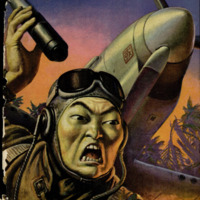 Popular Science Monthly, v. 146, n. 1, 1945
Popular Science Monthly, v. 146, n. 1, 1945



